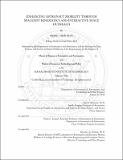Enhancing astronaut mobility through spacesuit kinematics and interactive space outreach
Author(s)
Bertrand, Pierre J. (Pierre Jean)
DownloadFull printable version (96.39Mb)
Other Contributors
Technology and Policy Program.
Advisor
Dava J. Newman.
Terms of use
Metadata
Show full item recordAbstract
Human spaceflight programs are facing new challenges rising from the evolution of the exploration agenda, as well as the changing international panel of actors. Planetary exploration missions will require intensive extravehicular activities (EVA). Simultaneously, the design of such missions will increasingly rely on cooperation between several types of actors: international and public/private. Adapting this paradigm shift requires astronauts, both symbols and key elements of human space exploration, to be fully equipped to explore and share their experiences. Consequently, astronaut mobility during the exploration mission, characterized by spacesuit kinematics, as well as astronaut mobility for space public outreach, characterized by the ability to inspire multiple types of people, are critical for the future of human spaceflight. This thesis focuses on these two elements of astronaut mobility: spacesuit motion and public inspiration for human spaceflight. All of the spacesuits currently in use are gas-pressurized and enable a wide range of astronaut performance. However, the pressurization causes an inherent stiffness, leading to astronauts' fatigue, unnecessary energy expenditure and limited mobility in the spacesuit. Better understanding of spacesuit kinematics is crucial to enable future human space exploration during extreme mobility tasks such as climbing, loping and excavating. Different methods are currently used to assess spacesuit mobility, but they are restricted to laboratory settings and do not measure the interactions between the suit and the person inside the suit. The first objective of this research is to develop a novel method to assess spacesuit kinematics and visualize human-spacesuit interactions. Upper body mobility of different suits was assessed by placing inertial measurement units (IMUs) on the person's body and on the outside of the spacesuit. IMUs incorporate accelerometers and gyroscopes to estimate relative rotation. They are mobile and low power, offering an economical and efficient kinematic tracking capability. A comparison of joint angle amplitude between different pressurization conditions and different motions was performed, and a 3D kinematic visualization tool was developed. While space-based technologies for Earth applications are flourishing, space exploration activities suffer from a lack of public awareness as well as decreasing budgets. Recent robotic exploration missions have positively influenced public perception by utilizing video and social media communication. How can these new communication technologies be used to better serve human spaceflight? How can space agencies and astronauts inspire tax-paying citizens, and thus politicians, to commit to an ambitious, global human spaceflight program based on international collaboration? The second part of the research analyzes how astronauts' use of interactive platforms can increase international public interest in human space exploration. An analysis of the Twitter network related to human spaceflight was performed, measuring how influence and relationships are linked, to better capture the best practices.
Description
Thesis: S.M. in Technology and Policy, Massachusetts Institute of Technology, Institute for Data, Systems, and Society, Technology and Policy Program, 2016. Thesis: S.M., Massachusetts Institute of Technology, Department of Aeronautics and Astronautics, 2016. This electronic version was submitted by the student author. The certified thesis is available in the Institute Archives and Special Collections. Cataloged from student-submitted PDF version of thesis. Includes bibliographical references (pages 212-225).
Date issued
2016Department
Massachusetts Institute of Technology. Department of Aeronautics and Astronautics; Massachusetts Institute of Technology. Engineering Systems Division; Massachusetts Institute of Technology. Institute for Data, Systems, and Society; Technology and Policy ProgramPublisher
Massachusetts Institute of Technology
Keywords
Institute for Data, Systems, and Society., Aeronautics and Astronautics., Engineering Systems Division., Technology and Policy Program.